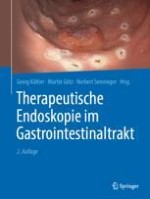Zusammenfassung
Die Entwicklung von Seitblickduodenoskopen in den 1970er Jahren hat in Verbindung mit Kanülierungsverfahren der Papille die kontrastmittelgestützte radiologische Darstellung der Gallen- und Pankreasgänge ermöglicht. Diese wurde früh ergänzt durch therapeutische Interventionen, beginnend mit der Erstbeschreibung der endoskopischen Papillotomie 1974. Die endoskopische retrograde Cholangiopankreatikographie (ERCP) unterscheidet sich von vielen anderen endoskopischen Verfahren dadurch, dass sie heute im Regelfall als therapeutische Intervention geplant wird. Die rein diagnostische ERCP kann häufig durch weniger invasive Verfahren wie die (Endo-)Sonographie, die Computertomographie und die Magnetresonanztomographie/MR-Cholangiopankreatikographie (MRCP) ersetzt werden. Im Gegensatz hierzu ist die therapeutische ERCP zur Behandlung von Gallengangs- und Pankreaskonkrementen, von Gangstrikturen und zur palliativen Therapie von Karzinomen durch neue Modalitäten ergänzt worden und in ihrem Stellenwert gewachsen.











